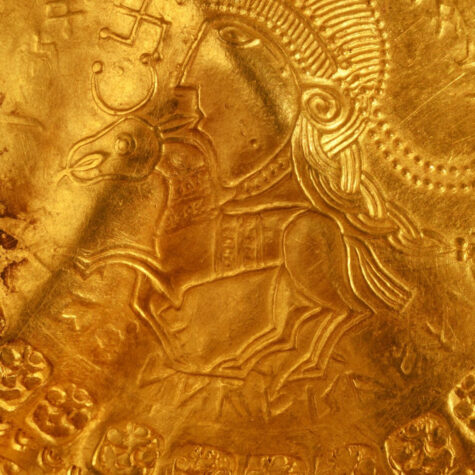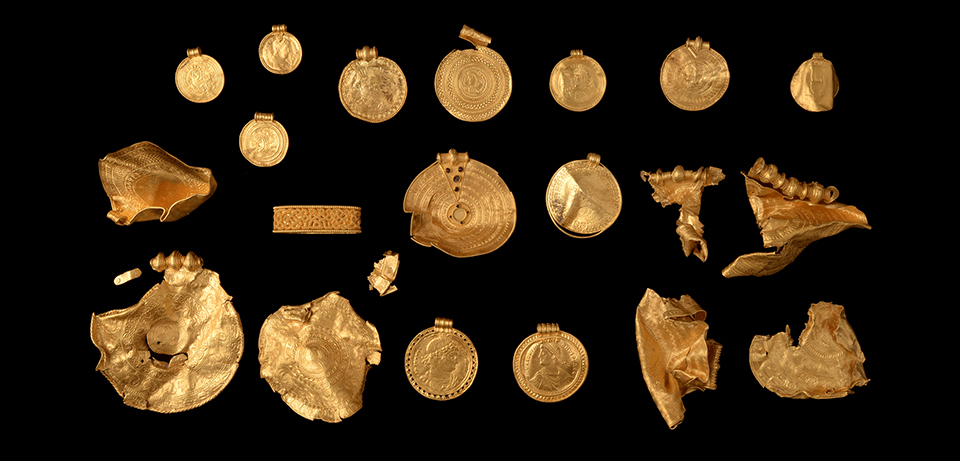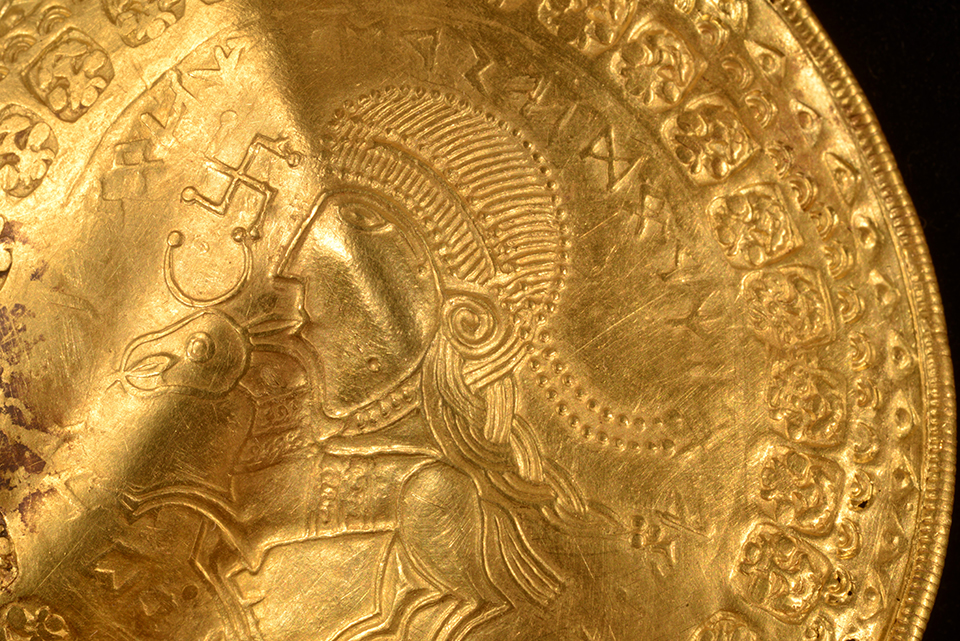In December 2020, an impressive hoard of gold bracteates, pendants and a scabbard mount was discovered. Dated to c. AD 335-540, the hoard is unique. Recently, the Runic inscription on one of the bracteates was deciphered, presenting us with the earliest Odin inscription.
Until recently, the oldest inscription featuring Odin was scratched into the Nordendorf Fibula from the mid-6th century. In Denmark, the oldest inscription to date was on an amulet made from a piece of a human skull found in Ribe. It dates back to the beginning of the 8th century.
Now, the inscription on one of the bracteates from Vindelev brings us a hundred years back into the migration period. The runes are as spectacular as those on the golden horns and may help researchers understand other prehistoric runic inscriptions. Lisbeth Imer, the National Museum of Denmark’s runologist and Krister Vasshus, a linguist, have made the discovery.
The inscription features on two of the thirteen bracteates discovered among four Roman imperial medallions. Also, the hoard held a gold fragment, a pendant with glass inlays, and a scabbard mount. Before the inscription’s spectacular decipherment, the find was considered unique. Not only did it muster the largest bracteate ever found, measuring 138 mm in diameter, but it also presented us with the first mix of bracteates and medallions since the discovery of the Zagorzyn hoard discovered in the 1920s. The four Roman medallions date to the period between AD 335–383. The Bracteates are considered to be very early, dating to the period between Ad 450 and 490. Although several belong to the artistic milieu connected with Funen, and more precisely Gudme, some of the bracteates are made from unique dies,
Hunter or King?

After the initial study of the gold bracteates revealed an inscription, the experts began deciphering the meaning. However, the Runic inscription was particularly complicated to work with. The bracteate is worn, and the runes have almost disappeared in significant places. The text is also written without spaces between the words and in a language over 1,500 years old.
The first part of the text is particularly challenging because it partly consists of words we do not know from other sources; also, they do not seem to fit with the linguistic history. Possibly, the inscription begins with the word hostiōz, which may mean ‘sacrificial animal’ (plural). In that case, it is a Latin loanword, meaning that the word “hostia” was adopted from Latin and embedded in the Old Norse language. Further, the long sequence, which follows, may be a declaration about someone helping a hunt or a hunter. This hunting motif may also be reflected in the (nick)name Jaga, which may even have been perceived as a pun on the verb ‘to hunt’.
The scholars are most confident about the last part of the inscription. It says iz Wōd[a]nas weraz, which can be translated as ‘he is Odin’s man’. Perhaps the sentence, He is Odin’s man, refers to the portrait on the bracteate of an unknown king, warlord, or hunter whose name (or nickname) may have been Jaga or Jagaz. The inscription implies that the gods we know from Norse mythology were already familiar at the beginning of the 5th century: 150 years earlier than previously established.
– Not only has the language structure developed tremendously since the 5th century, but many words have also fallen out of use,” says Krister Vasshus. “Generally, we find short runic inscriptions with somewhat comprehensible content, but this time the text is long and consists almost entirely of new words. That made it extremely difficult to interpret. In itself, the interpretation is quite a major achievement, which will help us understand other runic inscriptions – on other bracteates, he continues.
More than 1,000 bracteates have been found in Northern Europe, and more than 200 of them with inscriptions. But the vast majority of runic inscriptions on bracteates make no linguistic sense. The runes tend to be 2-3 mm high, and because they carry images, there is not much room left for inscriptions, which end up consisting of short, sacred words; or we read them as distorted or warped copies of inscriptions which once made sense, but are lost.
– This runic inscription is the most difficult I have ever had to interpret in all my years as a runologist at the National Museum of Denmark. But the discovery is also truly amazing. It is the earliest known example of Odin’s name inscribed on an artefact”, Lisbeth Imer tells us and continues – Since the golden horns, we have never seen such well-executed runes and such a long text on a Danish find from this period. The inscription have already helped us understand other prehistoric runic inscriptions,” continues Lisbeth Imer.
Thus, interpreting the new runic inscription the team have already solved another mystery. The Vindelev hoard also contains a second bracteate with an inscription akin to the deciphered Odin inscription. Unfortunately, this inscription is poorly executed by someone with a limited knowledge of runes. Thus, this second bracteate does not help us understand the murky parts of the Odin-inscription. Comparing the two bracteates, however, it appears the name Odin is spelled differently on the two bracteates because the scribe has swapped two runes. Where he wanted to write woþanas, he has written þowa(nas). Easily confused, the two runes represent the sounds /w/ and /þ/ and are are almost identical. Further, this second and more poorly crafted bracteate from Vindeløv turned out to have a ‘twin’ made with an identical stamp, found in 1852 at Bolbro on the outskirts of Odense. The National Museum of Denmark has had this in its collection for 170 years but could not decipher the script until now. All in all, we now have three different bracteates with versions of the same formulaic inscription. Somehow, this makes the identification of the man on the different bracteates as a specific person akin to the Roman emperors on the medallions less likely. On this matter, we have to wait on the full publication of the results.
Further, some of the other bracteates found at Vindeløv also hold inscriptions. Thus, one of the C-bracteates from a little later has a Runic inscription, at first identified as houaR, meaning “the High One, a nickname traditionally understood to refer to Odin. This reading at first was based on a superficial comparison with its twin found at Gudme. But Lisbeth Imer and Krister Vasshus say the reading is a misinterpretation. Because the runes are sharper and more distinctly carved on the new-found bracteate from Vindelev, we now know it reads “The Beloved”; perhaps a nickname for the horse or the person portrayed on the bracteate?

Portraits or Gods?
The identification of the bracteates as Northern Germanic and very distinctive versions of the Roman medallions featuring emperors or Roman warlords has been around for over 150 years. And for nearly as long, archaeologists and art historians have debated whether the figures on the bracteates were portraits of people or gods. But given that the subject is “Odin’s man” and (nick)named “Jaga” or “Jagaz”, it is probably a petty king. The man in question had been given divine legitimacy by Odin, which may mean he was also the supreme cult leader in the community.
Apart from runic inscriptions, we have no written sources from 5th-century Denmark, so we know very little about who this Odin’s man and Jaga or Jagaz was. However, everything would seem to indicate that he was an important warlord and/or cult leader in the 5th century. The Vindelev hoard weighs 794 g., and the gold bracteates are far larger and thicker than similar ones. They were probably worn on a kind of mayoral chain highlighting the status of the person wearing them. The gold was imported from the south, and the Roman medallions in the hoard, suggest Jagaz possessed a strong network down through Europe.
Together with the rest of the Vindelev hoard, the bracteate with the world’s oldest Odin inscription is on display at the National Museum of Denmark in the current exhibition, The Hunt for Denmark’s Past. Read more about the exhibition here.
The scientific presentation of the linguistic and runologic puzzle behind the inscriptions will be published in April in the next issue of Nowele
SOURCE:
Press Release National Museum of Copenhagen. March 2023
READ ALSO:
